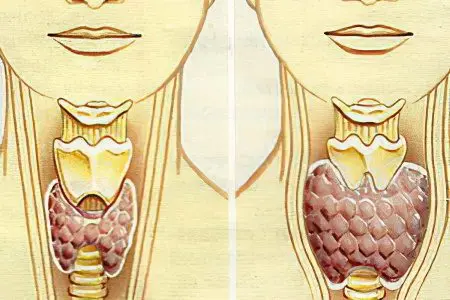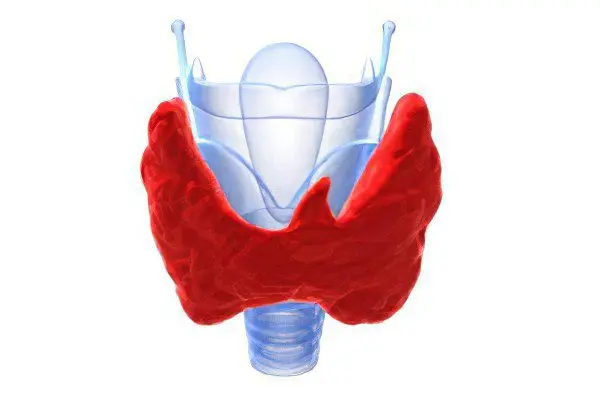Contents
What is hypothyroidism?

Hypothyroidism is a process that occurs due to a lack of thyroid hormones in the thyroid gland. This disease occurs in about one in a thousand men and nineteen out of a thousand women. Often there are cases when the disease is difficult to detect, and for a long time. The reason for the diagnostic difficulties is that the disease occurs and develops slowly, and it is characterized by signs that make it difficult to recognize hypothyroidism. Usually the symptoms are mistaken for simple overwork, in women – for pregnancy or something else.
Due to the occurrence and spread of this disease, the main metabolic processes in the body are inhibited, since thyroid hormones are responsible for energy metabolism.
Hypothyroidism:
It rarely becomes a separate disease associated with the pathology of the thyroid gland alone;
Not an independent disease and should not be the only diagnosis (except in rare cases);
It becomes a complication or a natural consequence of any pathology of the thyroid gland with the exception of hyperthyroidism;
It is based on functional disorders in the form of insufficient production of thyroid hormones (triiodothyronine, tetraiodothyronine (thyroxine), calcitonin), their inferiority or premature inactivation in tissues;
It causes a violation of the general hormonal background and metabolic processes in the body.
Each of these points requires a little clarification. After all, the prevalence of this pathology is very wide, which causes a high interest among the population in relation to expanding knowledge about it. Another name for extreme hypothyroidism is myxedema.
Hypothyroidism is rarely a single disease or the only diagnosis.
If we consider this statement from a pathogenetic point of view, then it is 100% true. The only exceptions are those cases when it is impossible to establish the primary cause of hypothyroidism, or clinical signs of hypothyroidism are recorded against the background of a normal amount of thyroid hormones. Then this disease may be the only diagnosis that sounds like “idiopathic hypothyroidism.”
In all other cases, there must necessarily be a primary disease that caused a violation of the functional abilities of the thyroid gland in relation to the synthesis of thyroid hormones. Prolonged course of hypothyroidism will certainly cause severe disorders in the body, which will be displayed as a layering of other diseases, in which it will become an unfavorable background for their further progression.
Hypothyroidism is a functional pathology of the thyroid gland with damage to the whole body.
Hypothyroidism is based not on organic changes in the tissues of the thyroid gland and their structural restructuring, but on a violation of the ability to synthesize the corresponding hormones (thyroxine, triiodothyronine, calcitonin).
The consequences that arise in this case cause other functional and even organo-anatomical disorders in almost all organs and tissues. After all, thyroid hormones are involved in important biochemical reactions that regulate the metabolic processes of protein and mineral metabolism and the synthesis of steroid and sex hormones, the growth and development of the musculoskeletal system, the functional abilities of the heart and brain. Hypothyroidism causes not only difficulty in the functioning of these organs, but also a violation of their anatomical structure.
Hypothyroidism – a syndrome of general hormonal imbalance

The endocrine system of the human body functions as a closed circuit. The loss of one of its links will necessarily slow down the work of the others. This is exactly what happens with hypothyroidism.
After all, the hormones thyroxine, triiodothyronine and calcitonin interact with:
Pituitary hormones that regulate the functioning of the thyroid gland – their lack stimulates the production of thyroid-stimulating hormone, which provokes the growth of the thyroid gland in diffuse volume, in the form of nodes or cancerous tumors;
Other tropic hormones of the hypothalamic-pituitary system – against the background of a decrease in thyroid and increased activity of thyroid-stimulating hormone, an increase in the amount of prolactin is possible. Such changes lead to permanent galactorrhea and changes in the mammary glands, and also further disrupt the synthesis of sex hormones by the ovaries;
Steroid hormones of the gonads and adrenal glands – the activity of their synthesis is significantly reduced, since thyroid hormones cannot provide adequate activity of protein metabolism in the liver. As a result, there is a lack of building material for steroids, which for the most part consist of protein, and hormonal insufficiency of the testicles, ovaries and adrenal glands;
Parathyroid glands – a lack of calcitonin causes a violation of calcium metabolism, which is the result of the leaching of calcium ions from the bone tissue from excessive parathyroid hormone activity.
In what case can hypothyroidism be an independent disease?
Those clinical variants of hypothyroidism, when the thyroid gland synthesizes a sufficient amount of hormones and their concentration in the blood is normal, are referred to as paradoxical types of the disease. This is truly incredible and seemingly impossible. After all, if thyroid hormones are produced normally, then where can the symptoms of hypothyroidism come from? It turns out that this also happens.
The main mechanism of this kind of conditions is the abnormal structure of thyroid hormones or their rapid destruction in the blood. Various autoimmune conditions are capable of triggering such pathological processes against the background of systemic diseases or after suffering a severe pathology (infections, injuries, pancreatic necrosis, burns). Despite a sufficient amount of the hormone circulating in the plasma, it is unable to fully fulfill its purpose, as it is inactivated by the person’s own immune cells. In the same way, clinical hypothyroidism also occurs when thyroxine receptors in its target organs are destroyed.
Symptoms of hypothyroidism

The clinical picture of hypothyroidism can be represented by symptoms of the underlying disease of the thyroid gland, which caused its dysfunction, and direct signs of hypothyroidism.
In short, the main symptoms of hypothyroidism are:
menstrual irregularities in women;
a sharp weight gain, albeit insignificant. It is caused by a drop in metabolic rate, but appetite is reduced, which prevents a significant increase in body weight;
feeling of nausea, bloating, constipation. The face and limbs may swell;
the hair of a sick person becomes dry and brittle, begins to fall out strongly;
the scalp may acquire a yellowish tint;
hearing impairment occurs and the voice changes (this symptom is characteristic of especially acute forms, and occurs due to swelling of the tongue, larynx and middle ear);
fatigue, weakness; thinking and speech become slower; there is a feeling of chills, which is caused by a slow metabolism.
All the symptoms are detailed in the table:
The affected organ system in hypothyroidism | Symptoms of the disease |
Skin and subcutaneous tissue |
|
Musculoskeletal system |
|
Heart and blood vessels |
|
Nervous system |
|
endocrine disorders |
|
Damage to the blood system |
|
Digestion and kidneys |
|
Causes of hypothyroidism
Hypothyroidism, as an endocrine disease, can occur due to direct damage to the thyroid gland and due to other pathologies associated with a violation of the functions and structure of the organs that regulate its work.
The main causes of hypothyroidism and etiological classification are given in the form of a table.
Etiological type of hypothyroidism | Immediate causes and diseases |
Primary (it is based on damage to the thyroid gland, which leads to its functional inferiority) |
|
Secondary (caused by a decrease in the activity of the pituitary gland in relation to the ability to synthesize thyroid-stimulating hormone) |
|
Tertiary (represented by damage to the hypothalamic nuclei) |
|
Peripheral (violation of the action of existing thyroid hormones) |
|
This disease can be very well camouflaged. The lack of thyroid hormones, especially in females, causes depression, a constant bad mood, and a feeling of incomprehensible sadness. In a sick person, intelligence can be hidden or openly reduced, attention and memory become poor, and cognitive function decreases. It becomes difficult for a person to fall asleep, insomnia begins, or, conversely, regularly sleeps.
The longer an undetected and untreated disease has spread since its onset, the greater the likelihood of an intracranial hypertension syndrome. A person complains of regular pain in the head. The patient can live in peace, thinking that cervical (or some other) osteochondrosis is to blame. Suspicions are also caused by muscle pain in the arms, a feeling of weakness in them, tingling and goosebumps. Hypothyroidism is also taken for heart disease, as blood pressure and cholesterol levels in the patient’s blood rise.
In the case of female hypothyroidism, mastopathy may develop, and menstruation fails.
Another symptom of the disease is swelling of certain parts of the body. Eyelids swell more often, other places – less often, but edema is still the main indicator of the presence of hypothyroidism. A repeated decrease in immunity in humans can have an impact on the appearance of the disease. And it can occur even with the smallest violation of the functioning of the thyroid gland. Another sign is anemia, which occurs because the thyroid gland is responsible for blood formation.
Primary hypothyroidism

Almost all cases of hypothyroidism are associated with a direct violation of the structure and functioning of the organ responsible for the synthesis of thyroid hormones. This organ is the thyroid gland. It is quite logical that the criteria for the degree of the pathological process in any organ are the severity of changes in its structure and the ability to perform the function that it is supposed to perform. With regard to primary hypothyroidism, the causal relationship is built in such a way that the thyroid gland, due to a violation of its structure, is not able to synthesize the hormones T4 and T3. This causes the clinical manifestations of hypothyroidism, which are superimposed on the symptoms of the underlying disease.
The main diseases of the thyroid gland that can cause primary hypothyroidism include congenital diseases in the form of underdevelopment or complete absence of an organ, inflammatory changes (thyroiditis), cancerous tumors and a banal endemic goiter with insufficient intake of iodine. Complete or partial removal of the thyroid gland also causes hypothyroidism of varying severity.
To conduct a differential diagnosis between all types of hypothyroidism and confirm the primary type will help:
Clinical findings – the presence of signs of thyroid damage (its enlargement, the presence of nodes, difficulty swallowing and sore throat) along with symptoms of hypothyroidism;
Data from ultrasound, MRI or radioisotope diagnostics, indicating the presence of structural changes in the thyroid gland and a decrease in its functional abilities;
Blood test to determine plasma concentration of thyroid hormones: T4, T3, TSH. In primary hypothyroidism, T3 and T4 levels are always low. TSH compensatory increases in order to enhance the stimulation of the thyroid gland to produce hormones, or remains within the normal range.
Secondary hypothyroidism

Secondary hypothyroidism is a type of decrease in the functional abilities of the thyroid gland, which occurs not as a result of damage to its tissues, but due to a violation of the regulation of functional activity in relation to the production of hormones. The thyroid gland, like any organ of the endocrine system, depends on the regulatory glands. These are the pituitary and hypothalamus. Speaking of secondary hypothyroidism, they mean a violation of the activity of hypothalamic thyroid-stimulating hormone. It is either not produced by the pituitary gland, or acquires an abnormal structure. In any case, a situation arises in which an anatomically healthy and unchanged thyroid gland is not able to synthesize thyroxine.
Various intracerebral pathological processes in the form of traumatic injuries, tumors, circulatory disorders in the cerebral arteries, and autoimmune destruction can cause damage to the glandular cells of the pituitary gland. With regard to clinical manifestations, secondary hypothyroidism differs from primary in that symptoms of damage to other endocrine glands, ovaries and adrenal glands, join the typical clinical picture. This causes more severe than with primary hypothyroidism, disorders of the muscular system and the heart, severe impairment of intellectual abilities, sexual disorders in the form of persistent amenorrhea and infertility, atrophy of the genital organs and mammary glands, excessive hair growth, sexual infantilism and electrolyte disorders.
Confirming secondary hypothyroidism can help:
Absence of clinical and instrumental signs of damage to the thyroid gland with a clear clinical picture of hypothyroidism;
Data of X-ray examination of the skull in two projections with the study of the area of the Turkish saddle, where the pituitary gland is located;
Computed tomography and MRI of the head, which will help determine the presence or absence of objective causes that caused secondary hypothyroidism;
Blood test to determine plasma concentrations of specific thyroid and pituitary hormones. Diagnostic criteria for secondary hypothyroidism are a decrease in the level of T3, T4 and TSH.
In some cases, we have to talk about tertiary hypothyroidism. It is also not associated with diseases of the thyroid gland, but is due to a violation of the regulation of its activity. In this case, the pathogenetic chain will be even more complicated, since the work of not one, but two links of regulatory processes is disrupted. The nuclei of the hypothalamic part of the brain are affected, which are responsible for the synthesis of hormones that regulate the activity of hormone production by the pituitary gland. In the case of tertiary hypothyroidism, everything looks like this: the hypothalamus does not produce thyreoliberin – the pituitary gland does not produce TSH – the thyroid gland does not produce thyroid hormones.
Consequences of hypothyroidism

Hypothyroidism can be conditionally divided into clinical forms of moderate and severe degrees. It all depends on the amount of thyroid hormones produced by the thyroid gland. If they are not present at all, the consequences will be simply catastrophic, and such hypothyroidism will acquire an extremely severe course. This form of hypothyroidism is called myxedema. With a partially preserved ability of the thyroid gland to produce hormones, the functioning of the body is disrupted, but such consequences are quite reversible and compatible with everyday life.
Patients with hypothyroidism should be aware that the following consequences may occur without appropriate hormone replacement therapy.
Children:
Lagging behind the child in mental and physical development, up to cretinism;
Delay in the appearance of secondary sexual characteristics, up to complete infantilism;
Heart problems;
A sharp decrease in the defenses of the immune system, which is manifested by frequent colds, severe exacerbations of chronic infections;
Severe weakness and inability of the child to bear physical activity.
In adults:
Decreased mental abilities, memory and intelligence;
Persistent heart problems;
Persistent lowering of blood pressure;
Prolonged course of chronic diseases and infectious processes;
Disorders of menstrual function;
Atrophy of the ovaries, external genital organs and mammary glands;
Sexual impotence, impotence and infertility;
Hypothyroid coma (a critical decrease in the level of hormones, leading to severe metabolic disorders up to a critical drop in cardiac activity and the brain, accompanied by a persistent loss of consciousness).
Treatment of hypothyroidism
The treatment process for hypothyroidism involves the impact on the main links of this disease and includes the following methods:
Etiotropic therapy
It involves treating the underlying disease or condition that caused hypothyroidism. Unfortunately, this kind of help is not always possible. Even when it is possible to act on the true cause of hypothyroidism, the effect is rare.
In the complex of etiotropic therapy, according to indications, the following can be used:
Iodine preparations. Indicated for endemic goiter due to iodine deficiency in food and its insufficient intake into the body;
Adequate treatment of inflammatory and other diseases of the thyroid gland that caused hypothyroidism;
X-ray therapy or other treatments for diseases of the hypothalamic-pituitary system;
Pathogenetic and symptomatic therapy
It suggests a slowdown in the progression of pathological changes in organs and tissues that occur against the background of the absence of thyroid hormones. This type of treatment can never be used as an independent, and always complements the basic treatment with hormonal drugs.
Replacement therapy with hormonal drugs
This type of treatment is the only correct solution for hypothyroidism. Hormones should become basic. All other activities are supportive. The principle of hormone replacement therapy is simple: the artificial introduction of thyroid hormones into the body.
Of the drugs containing thyroid hormones, thyroxine and triiodothyronine can be used. If earlier the second drug was used much more often, then modern endocrinologists have come to the conclusion that its use is inappropriate. T3 has a negative effect on the myocardium, aggravating heart damage against the background of hypothyroidism. The only situation where it can be more effective than thyroxine is a hypothyroid coma, in which intravenous administration of triiodothyronine has a fairly rapid therapeutic effect.
As for T4 hormone replacement therapy, it involves the use of drugs containing levothyroxine (L-thyroxine).
When prescribing thyroxin preparations, it is important to adhere to the following principles:
Lifetime admission is expected. The exception is cases of temporary primary hypothyroidism that occurs against the background of the pathology of the thyroid gland and in the early postoperative period after removal of its part;
Gradual dose titration taking into account the severity of hormonal deficiency, the age of the patient, the duration of the disease. The following pattern can be traced: the longer and more pronounced untreated hypothyroidism, the higher the body’s sensitivity to the action of hormonal drugs;
Mandatory performance monitoring treatment according to the signs of clinical improvement of the condition and according to the hormonal spectrum of the blood (increase in the concentration of T4, T3 and a decrease in TSH);
Use of small dosages in patients with concomitant heart disease. The dose in such patients should be increased very slowly under ECG control;
The expediency of a subsequent dose increase is evaluated after the maximum possible manifestation of the effectiveness of the previous one (at least 4-6 weeks).









